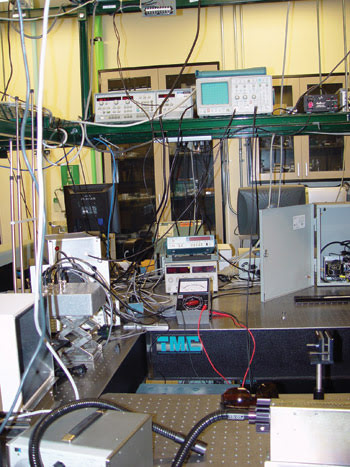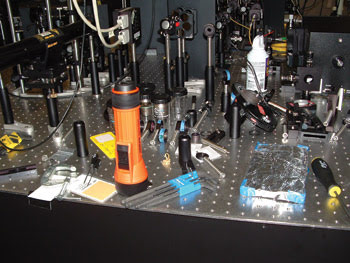Ken Barat, Laser Safety Officer, Lawrence Berkeley National Laboratory
Optical tables and your bed at home have several things in common. You spend a great deal of time with both. In addition, just like your bed, many things find their home on or underneath your optical table.
What does an optical table have to do with laser safety — or with safety in general, for that matter? Any horizontal surface provides an inviting storage space for all manner of odds and ends, and that space tends to fill up quickly. The greater the clutter on your optical table, the greater your safety risk from stray beams and from other hazards.

Shelves above an optical table may be handy, but they also can be dangerous if they can’t be reached easily or are so low that people might hit their heads.
To increase storage space in their labs, many researchers install shelves above their optical tables. This is an acceptable practice, but it also presents a head-banger hazard if not designed carefully. I have seen many an optical table under shelves whose corners and edges are padded with foam tubes or pillows. I’ve also sometimes seen unprotected shelves decorated with bloodstains.
Another hazard is high shelves that require you to balance on that wheeled desk chair to reach them. If you have shelves, make sure you have a stable step stool that allows easy access to them, in particular to the back, which can be a nest of wires and cables.
Clutter under the optical table is another common problem. Just as with the debris under a bed, out of sight is out of mind. What migrates beneath an optical table? Shipping containers (usually combustible in nature), pumps (dye or vacuum), excess equipment, and wires and hoses.
Clutter on the optical table is a more direct laser safety hazard. Not only do you now have additional reflective surfaces but there is also that sudden urge to reach in and grab a needed object — while your mind is oblivious to the beam that may reflect off your watch and into your eyes. I’ve seen too many optical tables where, just under the beam paths, there is a forest floor covered with plastic bags, lenses and mirrors, mounts, screwdrivers — and even the occasional unused protective eyewear.

Optical tables can become a place to store everything, which increases the number of reflective surfaces.
The proven way to combat the steady creep of clutter is to have a regular housekeeping day each week. And, of course, it’s always good to get into the habit of putting things away when you’re done using them. (Do I sound like your mother?)
One other solution to optical table clutter is to use the vertical table approach. Mounting laser tables vertically is not unheard of and, as with driving on the wrong side of the road, simply takes some getting used to. Some other organizational solutions are pockets on the sides of nonfloating optical tables (such as a tool belt), lockable storage cabinets in the hall, or sets of plastic storage bins under the optical table and hanging on the walls.
The optical table is the center of activities in most laser research labs. Take a careful look at your optical table and see what’s there that doesn’t need to be. Don’t be afraid to toss out old components that haven’t been used in years. Considering all the time you spend around your optical table, you should want it to be as comfortable as your bed.
Meet the author
Ken Barat is a laser safety officer at Lawrence Berkeley National Laboratory in Berkeley, Calif., and has held the same position with the National Ignition Facility Directorate at Lawrence Livermore National Laboratory in Livermore, Calif.; e-mail: [email protected].